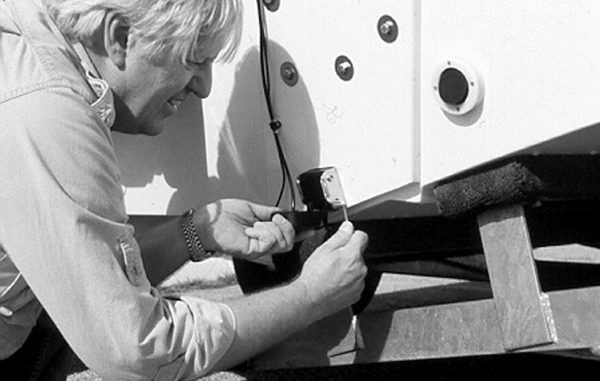
The harvest is ripe for this luscious fish at the near-shore rigs in October.
Gremlins almost never bother your fish finder in waters near your home or close to a repair shop. They wait until you pull your boat a hundred miles from home on vacation. Here’s how to defend against these little wire chewers and slug it out with them when they get past your defenses.Sonar systems have three main parts: a power source; a head unit containing most of the electronics, controls and the display; and a transducer. A power-supply problem is the most likely culprit when a fish finder operates intermittently or fails to turn on.
You can keep a digital volt meter in your fish-finder’s first-aid kit to help track down a bad connection, but I have a faster solution. Keep a length of conductor wire in your emergency kit long enough to reach from your battery to your fish finder so you can bypass all hidden wiring problems and get power straight to the unit.
The perfect emergency wire will have a spare fish-finder power plug on one end and a pair of ring connectors or alligator clips on the other.
An in-line fuse will be installed in the positive wire close to its battery connection. Hook up this emergency jumper, and if the unit works, you know you have a wiring problem that you can fix after your fishing trip.
The only way to troubleshoot your fish finder’s head unit out in the field is to swap it out with another similar unit. Guides and professional tournament fishermen usually carry spare units or rig their boats with multiple fish finders (like one on the console and one at the bow) that are interchangeable and can be swapped out in an emergency.
Another possibility is to locate an angler in another boat with a unit like yours and temporarily swap your unit with his. If his works on your boat and yours does not work on his, then you know your power and transducer cables are OK, and the problem is in your unit.
If you can get your head unit to power up but can’t make it work right, turn it on and find the option in its menu that resets everything to factory defaults.
Sometimes the wrong buttons get pressed by accident, and it’s difficult to find and adjust the features that are acting up. The master reset option takes care of all such problems and takes you back to square one.
When your unit loses the bottom when you plane your boat, shows a weak bottom image or suffers from a lack of display detail your transducer may be at fault.
If your transducer is mounted outside on the transom, make sure that it hasn’t kicked up after striking something and is still set at the proper angle and running depth. Look for cable damage like kinks or breaks in the insulation.
Your emergency kit should include the tools necessary to adjust your transducer on its bracket.
A transducer glued down inside the bilge to shoot through the hull may not be as easy to inspect. If you can reach it, make sure it hasn’t come loose and that a battery or fuel tank hasn’t shifted and damaged it or its cable.
Sometimes a transducer begins to separate from the hull and performance-reducing air gaps form in the epoxy holding it in place. You may be able to temporarily restore normal performance by adding enough water in the bilge area to cover the transducer.
If the water can displace the air between the transducer and the hull, the unit will resume normal operation. A transducer that has come loose can be put back in its original position and held in place with something heavy like a sandbag.
Add enough water to the bilge to cover the transducer, and you should be back in business.
Carrying a spare transducer can help two ways. First, you can connect it to your fish-finder and hold it over the side. If the fish finder works, you know the problem lies with your installed transducer or its cable.
In the case of a failed, lost or damaged transducer, you may be able to place your spare in the bilge, hold it in place with something heavy, cover it with water and then use it until you can make a permanent replacement.
A little knowledge and an emergency kit can save the day when even the worst fish-finder gremlins strike.


